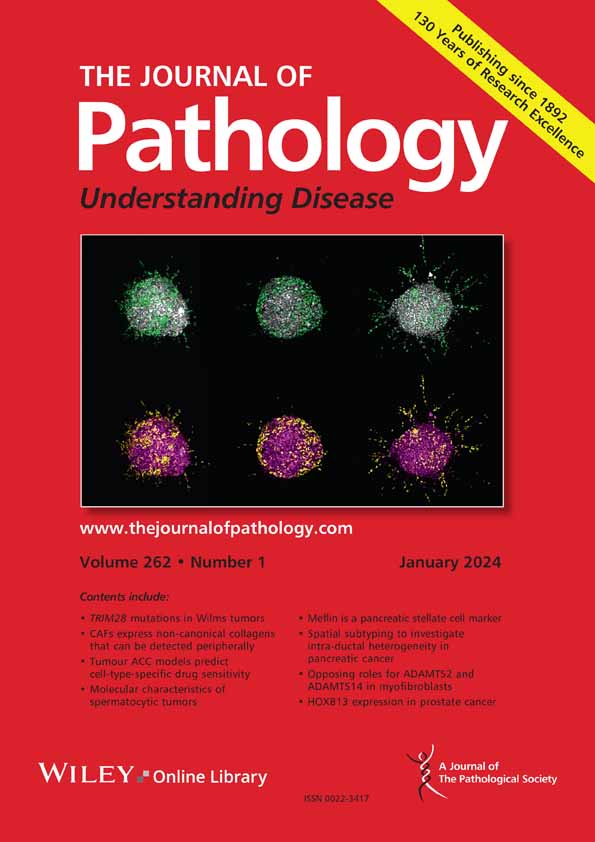下载PDF
{"title":"DNA甲基化模式受Pax3::Foxo1表达和基因工程小鼠横纹肌肉瘤肿瘤形成的发育谱系的影响。","authors":"Wenyue Sun, Stephen M Hewitt, Hollis Wright, Charles Keller, Frederic G Barr","doi":"10.1002/path.6386","DOIUrl":null,"url":null,"abstract":"<p>Rhabdomyosarcoma (RMS) is a family of phenotypically myogenic paediatric cancers consisting of two major subtypes: fusion-positive (FP) RMS, most commonly involving the <i>PAX3</i>::<i>FOXO1</i> fusion gene, formed by the fusion of paired box 3 (<i>PAX3</i>) and forkhead box O1 (<i>FOXO1</i>) genes, and fusion-negative (FN) RMS, lacking these gene fusions. In humans, DNA methylation patterns distinguish these two subtypes as well as mutation-associated subsets within these subtypes. To investigate the biological factors responsible for these methylation differences, we profiled DNA methylation in RMS tumours derived from genetically engineered mouse models (GEMMs) in which various driver mutations were introduced into different myogenic lineages. Our unsupervised analyses of DNA methylation patterns in these GEMM tumours yielded two major clusters, corresponding to high and no/low expression of <i>Pax3</i>::<i>Foxo1</i>, which mirrored the results for human FP and FN RMS tumours. Two distinct methylation-defined subsets were found for GEMM RMS tumours with no/low <i>Pax3</i>::<i>Foxo1</i> expression: one subset enriched in <i>Pax7</i> lineage tumours and a second subset enriched in myogenic factor 5 (<i>Myf5</i>) lineage tumours. Integrative analysis of DNA methylation and transcriptomic data in mouse and human RMS revealed a common group of differentially methylated and differentially expressed genes, highlighting a conserved set of genes functioning in both human RMS models and GEMMs of RMS. In conclusion, these studies provide insight into the roles of oncogenic fusion proteins and developmental lineages in establishing DNA methylation patterns in FP and FN RMS respectively. © 2025 The Author(s). <i>The Journal of Pathology</i> published by John Wiley & Sons Ltd on behalf of The Pathological Society of Great Britain and Ireland. This article has been contributed to by U.S. Government employees and their work is in the public domain in the USA.</p>","PeriodicalId":232,"journal":{"name":"The Journal of Pathology","volume":"265 3","pages":"316-329"},"PeriodicalIF":5.2000,"publicationDate":"2025-01-15","publicationTypes":"Journal Article","fieldsOfStudy":null,"isOpenAccess":false,"openAccessPdf":"https://onlinelibrary.wiley.com/doi/epdf/10.1002/path.6386","citationCount":"0","resultStr":"{\"title\":\"DNA methylation patterns are influenced by Pax3::Foxo1 expression and developmental lineage in rhabdomyosarcoma tumours forming in genetically engineered mouse models\",\"authors\":\"Wenyue Sun, Stephen M Hewitt, Hollis Wright, Charles Keller, Frederic G Barr\",\"doi\":\"10.1002/path.6386\",\"DOIUrl\":null,\"url\":null,\"abstract\":\"<p>Rhabdomyosarcoma (RMS) is a family of phenotypically myogenic paediatric cancers consisting of two major subtypes: fusion-positive (FP) RMS, most commonly involving the <i>PAX3</i>::<i>FOXO1</i> fusion gene, formed by the fusion of paired box 3 (<i>PAX3</i>) and forkhead box O1 (<i>FOXO1</i>) genes, and fusion-negative (FN) RMS, lacking these gene fusions. In humans, DNA methylation patterns distinguish these two subtypes as well as mutation-associated subsets within these subtypes. To investigate the biological factors responsible for these methylation differences, we profiled DNA methylation in RMS tumours derived from genetically engineered mouse models (GEMMs) in which various driver mutations were introduced into different myogenic lineages. Our unsupervised analyses of DNA methylation patterns in these GEMM tumours yielded two major clusters, corresponding to high and no/low expression of <i>Pax3</i>::<i>Foxo1</i>, which mirrored the results for human FP and FN RMS tumours. Two distinct methylation-defined subsets were found for GEMM RMS tumours with no/low <i>Pax3</i>::<i>Foxo1</i> expression: one subset enriched in <i>Pax7</i> lineage tumours and a second subset enriched in myogenic factor 5 (<i>Myf5</i>) lineage tumours. Integrative analysis of DNA methylation and transcriptomic data in mouse and human RMS revealed a common group of differentially methylated and differentially expressed genes, highlighting a conserved set of genes functioning in both human RMS models and GEMMs of RMS. In conclusion, these studies provide insight into the roles of oncogenic fusion proteins and developmental lineages in establishing DNA methylation patterns in FP and FN RMS respectively. © 2025 The Author(s). <i>The Journal of Pathology</i> published by John Wiley & Sons Ltd on behalf of The Pathological Society of Great Britain and Ireland. This article has been contributed to by U.S. Government employees and their work is in the public domain in the USA.</p>\",\"PeriodicalId\":232,\"journal\":{\"name\":\"The Journal of Pathology\",\"volume\":\"265 3\",\"pages\":\"316-329\"},\"PeriodicalIF\":5.2000,\"publicationDate\":\"2025-01-15\",\"publicationTypes\":\"Journal Article\",\"fieldsOfStudy\":null,\"isOpenAccess\":false,\"openAccessPdf\":\"https://onlinelibrary.wiley.com/doi/epdf/10.1002/path.6386\",\"citationCount\":\"0\",\"resultStr\":null,\"platform\":\"Semanticscholar\",\"paperid\":null,\"PeriodicalName\":\"The Journal of Pathology\",\"FirstCategoryId\":\"3\",\"ListUrlMain\":\"https://pathsocjournals.onlinelibrary.wiley.com/doi/10.1002/path.6386\",\"RegionNum\":2,\"RegionCategory\":\"医学\",\"ArticlePicture\":[],\"TitleCN\":null,\"AbstractTextCN\":null,\"PMCID\":null,\"EPubDate\":\"\",\"PubModel\":\"\",\"JCR\":\"Q1\",\"JCRName\":\"ONCOLOGY\",\"Score\":null,\"Total\":0}","platform":"Semanticscholar","paperid":null,"PeriodicalName":"The Journal of Pathology","FirstCategoryId":"3","ListUrlMain":"https://pathsocjournals.onlinelibrary.wiley.com/doi/10.1002/path.6386","RegionNum":2,"RegionCategory":"医学","ArticlePicture":[],"TitleCN":null,"AbstractTextCN":null,"PMCID":null,"EPubDate":"","PubModel":"","JCR":"Q1","JCRName":"ONCOLOGY","Score":null,"Total":0}
引用次数: 0
引用
批量引用






 求助内容:
求助内容: 应助结果提醒方式:
应助结果提醒方式:


